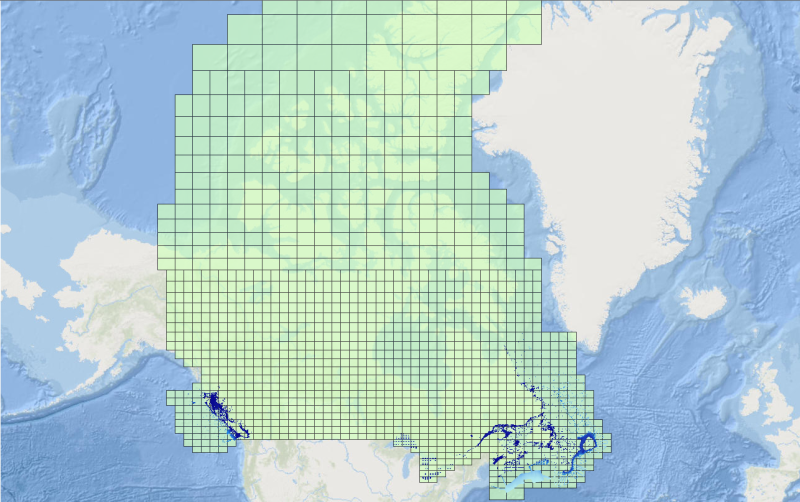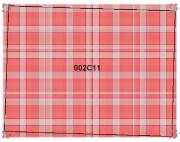imageryBaseMapsEarthCover
Type of resources
Available actions
Topics
Keywords
Contact for the resource
Provided by
Years
Formats
Representation types
Update frequencies
status
Scale
Resolution
-

Each pixel value corresponds to the quality control, cloud cover and snow fraction value for each pixel in the Best-Quality Max-NDVI product.
-

McElhanney Consulting Services Ltd (MCSL) has performed a LiDAR and Imagery survey in southern Saskatchewan. The acquisition was completed between the 16th and 25th of October, 2009. The survey consisted of approximately 790 square kilometers of coverage. While collecting the LiDAR data, we also acquired aerial photo in RGB and NIR modes consisting of 1649 frames each.
-

CHS offers 500-metre bathymetric gridded data for users interested in the topography of the seafloor. This data provides seafloor depth in metres and is accessible for download as predefined areas.
-

The Canada Centre for Mapping and Earth Observation (CCMEO) has created a 30m resolution radar mosaic of Canada's landmass from the RADARSAT Constellation Mission (RCM). This product highlights different types of radar interaction with the surface, which can assist the interpretation and study of land cover on a national scale. The national mosaic is made up of 3222 RCM images acquired between August 2023 and February 2024. (Credit: RADARSAT Constellation Mission imagery © Government of Canada [2024]. RADARSAT is an official mark of the CSA.)
-

Portions of Universal Transverse Mercator Zones 7 - 12 which cover British Columbia, Northern Hemisphere only, formed into polygons, in BC Albers projection
-

CHS offers 500-metre bathymetric gridded data for users interested in the topography of the seafloor. This data provides seafloor depth in metres and is accessible for download as predefined areas.
-

This collection is a legacy product that is no longer maintained. It may not meet current government standards. The correction matrices for the National Topographic Data Base (NTDB), also known under the acronym CORMAT, are products derived from the planimetric enhancement of NTDB data sets at the 1:50 000 scale. The correction matrix enables users to enhance the geometric accuracy of the less accurate NTDB. The matrix is a set of points arrayed on a regular 100-m grid. Each point describes the planimetric correction (DX, DY) to be applied at this location. The position of the points is given in UTM (Universal Transverse Mercator projection) coordinates based on the North American Datum of 1983 (NAD83) . Each file constitutes a rectangular area covering the entire corresponding NTDB data set. Its delimitation corresponds more or less to National Topographic System (NTS) divisions at the 1:50 000 scale. All NTDB data sets at the 1:50 000 scale whose original accuracy was less than 30 m can thus be geometrically corrected. A CORMAT data set contains a list of coordinates and the corresponding corrections to be applied in the form X Y DX DY. Related Products: [National Topographic Data Base (NTDB), 1944-2005](https://open.canada.ca/data/en/dataset/1f5c05ff-311f-4271-8d21-4c96c725c2af)
-

Each pixel value corresponds to the best quality maximum NDVI recorded within that pixel over the week specified. Poor quality pixel observations are removed from this product. Observations whose quality is degraded by snow cover, shadow, cloud, aerosols, and/or low sensor zenith angles are removed (and are assigned a value of “missing data”). In addition, negative Max-NDVI values, occurring where R reflectance > NIR reflectance, are considered non-vegetated and assigned a value of 0. This results in a Max-NDVI product that should (mostly) contain vegetation-covered pixels. Max-NDVI values are considered high quality and span a biomass gradient ranging from 0 (no/low biomass) to 1 (high biomass).
-

This group of maps, which includes the CanMatrix and CanTopo collections, is now a legacy product that is no longer maintained. It may not meet current government standards. Natural Resources Canada's (NRCan) topographic raster maps provide a representation of the topographic phenomena of the Canadian landmass. Several editions of paper maps have been produced over time in order to offer improved products compared to their predecessors in terms of quality and the most up to date information possible. The georeferenced maps can be used in a Geographic Information System (GIS). In all cases, they accurately represent the topographical data available for the date indicated (validity date). The combination of CanMatrix and CanTopo data provides complete national coverage. • CanMatrix - Print Ready: Raster maps produced by scanning topographic maps at scales from 1:25 000 to 1:1 000 000. This product is not georeferenced. Validity dates: 1944 to 2005 (1980 on average). Available formats: PDF and TIFF • CanMatrix - Georeferenced: Raster maps produced by scanning topographic maps at scales of 1:50 000 and 1:250 000. These maps are georeferenced according to the 1983 North American Reference System (NAD 83). Validity dates: 1944 to 2005 (1980 on average). Available format: GeoTIFF • CanTopo: Digital raster maps produced mainly from the GeoBase initiative, NRCan digital topographic data, and other sources. Approximately 2,234 datasets (maps) at scale of 1:50 000, primarily covering northern Canada, are available. CanTopo datasets in GeoPDF and GeoTIFF format are georeferenced according to the 1983 North American Reference System (NAD 83). Validity dates: 1946 to 2012 (2007 on average). Available formats: PDF, GeoPDF, TIFF and GeoTIFF
-

Note: To visualize the data in the viewer, zoom into the area of interest. The National Air Photo Library (NAPL) of Natural Resources Canada archives over 6 million aerial photographs covering all of Canada, some of which date back to the 1920s. This collection includes Time Series of aerial orthophoto mosaics over a selection of major cities or targeted areas that allow the observation of various changes that occur over time in those selected regions. These mosaics are disseminated through the Data Cube Platform implemented by NRCan using geospatial big data management technologies. These technologies enable the rapid and efficient visualization of high-resolution geospatial data and allow for the rapid generation of dynamically derived products. The data is available as Cloud Optimized GeoTIFF (COG) for direct access and as Web Map Services (WMS) or Web Coverage Services (WCS) with a temporal dimension for consumption in Web or GIS applications. The NAPL mosaics are made from the best spatial resolution available for each time period, which means that the orthophotos composing a NAPL Time Series are not necessarily coregistrated. For this dataset, the spatial resolutions are: 75 cm for the year 1960 and 50 cm for the year 1974. The NAPL indexes and stores federal aerial photography for Canada, and maintains a comprehensive historical archive and public reference centre. The Earth Observation Data Management System (EODMS) online application allows clients to search and retrieve metadata for over 3 million out of 6 million air photos. The EODMS online application enables public and government users to search and order raw Government of Canada Earth Observation images and archived product managed by NRCan such as aerial photos and satellite imagery. To access air photos, you can visit the EODMS web site: https://eodms-sgdot.nrcan-rncan.gc.ca/index-en.html
 Arctic SDI catalogue
Arctic SDI catalogue